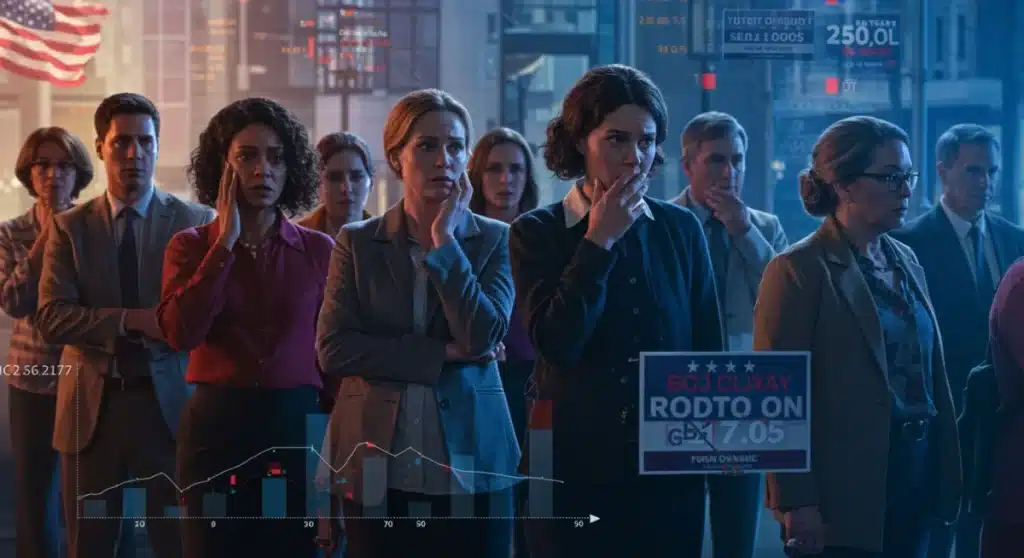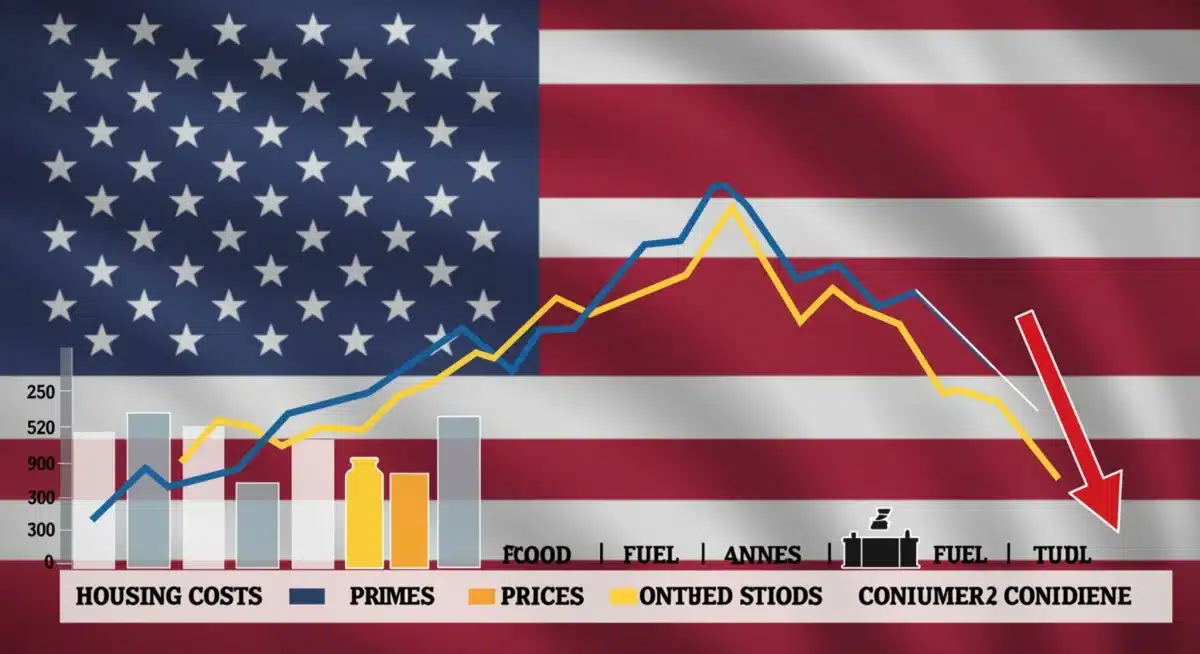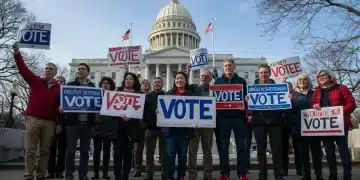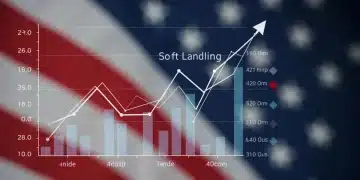Rising Cost of Living: Voter Sentiment in Upcoming Elections

The rising cost of living is a pivotal factor reshaping voter sentiment, driving political narratives, and influencing election results as citizens grapple with economic pressures and seek effective leadership.
As election seasons approach, a critical question emerges: How will the rising cost of living affect voter sentiment in the upcoming elections? This economic reality, characterized by escalating prices for essentials like housing, food, and fuel, is increasingly dominating household budgets and, consequently, political discussions across the United States. Understanding its profound impact is key to deciphering future electoral outcomes.
The Pervasive Impact of Inflation on Daily Life
The relentless climb in the cost of living has become more than just a talking point; it’s a daily struggle for millions of Americans. From the grocery store checkout to the gas pump, the financial strain is palpable, forcing families to make difficult choices and re-evaluate their spending habits. This immediate and personal impact translates directly into how citizens view their political leaders and the efficacy of current economic policies.
Everyday Financial Strain
For many, the rising cost of living means less discretionary income and increased financial anxiety. This isn’t just about luxury items; it’s about the fundamental ability to maintain a decent standard of living. When basic necessities become unaffordable, frustration mounts, and voters begin to seek solutions from their elected officials.
- Grocery Bills: Food prices have seen significant increases, making weekly shopping a budget challenge.
- Housing Costs: Rent and mortgage payments continue to rise, squeezing household finances.
- Fuel Prices: Transportation costs remain a major concern for commuters and businesses alike.
- Healthcare Expenses: The ongoing burden of medical costs adds another layer of financial stress.
The cumulative effect of these rising costs is a pervasive sense of economic insecurity. Voters, regardless of their political affiliation, are primarily concerned with their financial well-being. This economic insecurity often overshadows other policy debates, pushing economic stability to the forefront of electoral priorities. When voters feel their economic future is uncertain, they tend to hold incumbents and ruling parties accountable, demanding tangible solutions and relief.
This widespread economic pressure creates a fertile ground for political narratives centered on affordability and economic justice. Candidates who can articulate a clear vision for alleviating these pressures often resonate more strongly with the electorate. Conversely, those perceived as out of touch with the struggles of everyday Americans risk alienating a significant portion of the voting base. The daily grind of managing rising costs shapes not just individual opinions, but a collective sentiment that can swing elections.
Economic Discontent and Voter Behavior
Economic discontent is a powerful motivator in shaping voter behavior. When individuals perceive that their economic situation is worsening or that the government is failing to address their financial hardships, they are more likely to seek change at the ballot box. This dissatisfaction can manifest in various ways, from increased voter turnout to shifts in party loyalty.
Shifts in Political Allegiance
Historically, economic downturns or periods of high inflation have often led to significant shifts in political power. Voters, feeling the pinch, may abandon parties they once supported in favor of candidates who promise immediate economic relief or a different approach to fiscal policy. This phenomenon is not limited to any single demographic; it cuts across income levels, age groups, and geographical regions.
The current economic climate, marked by persistent inflation and stagnant wage growth for many, is creating a similar environment. Many voters are looking beyond traditional party lines, seeking leaders who demonstrate a genuine understanding of their economic struggles and offer credible plans to address them. This can lead to unexpected electoral outcomes, as established political figures may find themselves vulnerable to challengers who tap into this widespread economic anxiety.
Impact on Turnout
Economic discontent can also influence voter turnout. For some, frustration with the economic situation may lead to disengagement, resulting in lower participation. However, for many others, the urgency of their financial circumstances can act as a powerful catalyst, driving them to the polls in hopes of effecting change. The key factor often lies in whether voters believe their vote can truly make a difference in their economic reality.
- Increased Engagement: Voters feeling economic pressure may become more politically active.
- Demand for Accountability: Incumbents face heightened scrutiny over economic performance.
- Focus on Policy: Economic policies become central to candidate platforms and voter decisions.
- Search for Solutions: Voters prioritize candidates offering concrete plans for economic relief.
The narrative around economic solutions becomes paramount. Candidates must not only acknowledge the problem but also present clear, actionable strategies. Vague promises or a lack of detailed plans can be detrimental, as voters are increasingly sophisticated in discerning genuine commitment from political rhetoric. The interplay between voter frustration and proposed solutions will largely dictate turnout and, ultimately, election results.
Political Narratives and Campaign Strategies
In an environment dominated by concerns over the cost of living, political narratives and campaign strategies inevitably pivot to address these anxieties. Parties and candidates are keenly aware that economic issues often trump others in the minds of voters, especially when those issues directly impact their daily lives. Therefore, crafting a compelling economic message becomes a cornerstone of any successful campaign.
Framing the Economic Debate
Political campaigns will meticulously frame the economic debate, often attempting to assign blame for the current economic conditions or to present themselves as the sole arbiters of economic recovery. This involves highlighting specific data points, personal anecdotes, and policy proposals designed to resonate with voters experiencing financial stress.
For example, opposition parties typically focus on the failures of the incumbent administration to control inflation and improve living standards, proposing alternative policies. The governing party, conversely, often emphasizes positive economic indicators, attributes challenges to global factors, and highlights efforts already underway to mitigate the impact of rising costs. The effectiveness of these narratives hinges on their ability to connect with the lived experiences of voters and offer a credible path forward.
Policy Promises and Pledges
Candidates will undoubtedly make numerous policy promises aimed at alleviating the burden of the rising cost of living. These can range from tax cuts and subsidies to wage increases and regulatory reforms. The credibility and feasibility of these pledges will be heavily scrutinized by voters and the media.
- Tax Relief: Proposals for reducing income or sales taxes to boost disposable income.
- Wage Increases: Calls for raising the minimum wage or promoting collective bargaining.
- Affordable Housing Initiatives: Plans to increase housing supply or provide rental assistance.
- Energy Subsidies: Policies aimed at reducing fuel and utility costs for consumers.
The ability of a candidate to communicate these policies clearly and demonstrate how they will directly benefit the average American household will be crucial. Voters are looking for concrete solutions, not just abstract economic theories. Campaigns that successfully translate complex economic ideas into relatable benefits for families will gain a significant advantage.
Furthermore, the perceived authenticity of these promises matters. Voters are often wary of politicians who appear to be opportunistically addressing economic concerns without a deep understanding or long-term commitment. Campaigns that can convey empathy and a genuine desire to improve economic conditions will build greater trust with the electorate.
Demographic Divides and Economic Vulnerability
The impact of the rising cost of living is not uniformly distributed across the population; certain demographic groups are disproportionately affected, leading to distinct patterns of economic vulnerability and, consequently, varying voter sentiments. Understanding these divides is essential for political strategists and for comprehending the broader electoral landscape.

Generational Gaps
Younger generations, particularly millennials and Gen Z, often face unique economic challenges. They are frequently burdened with student loan debt, struggle to afford housing in competitive markets, and may have entered the workforce during periods of economic instability. The rising cost of living exacerbates these pre-existing vulnerabilities, making it harder for them to achieve financial independence and stability.
Older generations, while potentially having more established assets, may also be vulnerable, especially those on fixed incomes or relying heavily on retirement savings. Inflation can erode the purchasing power of their pensions and investments, creating anxiety about their ability to maintain their lifestyle or cover unexpected expenses. These generational differences in economic experience often translate into different political priorities and voting patterns.
Income and Racial Disparities
Lower-income households and communities of color are typically hit hardest by the rising cost of living. These groups often spend a larger proportion of their income on essential goods and services, meaning that even small price increases can have a significant impact on their financial solvency. Systemic inequalities can also limit their access to resources that could mitigate these economic pressures, such as stable employment, affordable healthcare, or generational wealth.
- Low-Income Households: Disproportionately affected by food and energy price increases.
- Minority Communities: Often face greater barriers to economic mobility and wealth accumulation.
- Single-Parent Households: Manage tight budgets with limited resources, exacerbating inflation’s impact.
- Rural vs. Urban: Different cost structures and access to services create distinct economic pressures.
These disparities mean that political messages aimed at addressing the cost of living must be nuanced and targeted. A one-size-fits-all approach may fail to resonate with the diverse experiences of the electorate. Candidates who can demonstrate an understanding of these specific vulnerabilities and propose tailored solutions are more likely to gain support from these key demographic groups. The political implications of these economic divides are profound, shaping coalition building and electoral strategies.
The Role of Media and Public Discourse
The way the rising cost of living is presented and discussed in the media and public discourse plays a crucial role in shaping voter sentiment. Media outlets, social media platforms, and political commentators all contribute to the narrative surrounding economic conditions, influencing how voters perceive the problem and potential solutions.
Media Framing of Economic News
News organizations have a significant impact on public perception. The emphasis they place on inflation, consumer prices, and economic hardship can either amplify or temper public anxiety. Headlines focusing on record gas prices or soaring grocery bills can create a sense of urgency and distress, directly impacting how voters feel about the economy and the performance of elected officials.
Conversely, reports highlighting positive economic indicators, such as job growth or declining unemployment, might offer a more optimistic outlook. However, for many voters, the personal experience of rising costs often overrides official statistics, making the media’s ability to connect with lived realities particularly important. The balance between objective reporting and the emotional resonance of economic stories is a delicate one that profoundly influences voter sentiment.
Social Media and Information Echo Chambers
Social media platforms have become powerful amplifiers of economic grievances. Personal stories of financial struggle, shared widely, can quickly create a collective sense of hardship and frustration. These platforms also contribute to the formation of echo chambers, where individuals are primarily exposed to information that confirms their existing economic anxieties, potentially hardening their views against incumbent politicians or specific economic policies.
- Amplified Concerns: Personal stories of economic hardship go viral, increasing public awareness.
- Policy Debates: Social media becomes a forum for discussing economic policies and their impact.
- Misinformation: The spread of inaccurate economic data can further confuse and frustrate voters.
- Mobilization: Social media can mobilize voters around economic issues, driving political action.
The rapid dissemination of information, both accurate and inaccurate, through social media means that political campaigns must be agile in responding to evolving narratives. The public discourse around the cost of living is not just shaped by traditional media but by a decentralized network of voices, all contributing to the complex tapestry of voter sentiment. Understanding this dynamic is crucial for any political entity seeking to influence public opinion.
Historical Precedents and Future Projections
Examining historical precedents offers valuable insights into how the rising cost of living might affect voter sentiment in the upcoming elections. Economic conditions have long been a decisive factor in electoral outcomes, and past patterns can help us project potential future scenarios. While no two economic periods are identical, certain recurring themes emerge.
Lessons from Past Economic Cycles
Throughout American history, periods of significant inflation or economic stagnation have often coincided with shifts in political power. Voters tend to punish administrations perceived as failing to manage the economy effectively, particularly when their personal finances are negatively impacted. The 1970s, for example, saw widespread public discontent over stagflation, leading to significant political realignments.
Similarly, the Great Recession of 2008-2009 profoundly influenced subsequent elections, as voters demanded accountability and new economic leadership. These historical examples underscore the potent link between economic performance and electoral success. Voters often prioritize tangible relief over ideological purity when their wallets are feeling the strain.
Forecasting Electoral Impact
Projecting the future impact of the rising cost of living on voter sentiment involves considering several variables. The duration and severity of the current inflationary period, the effectiveness of government interventions, and the communication strategies of political actors all play a role. If inflation persists and wages fail to keep pace, voter frustration is likely to intensify, potentially leading to a strong desire for change.

- Sustained Inflation: Prolonged periods of high prices will likely increase voter dissatisfaction.
- Policy Effectiveness: The perceived success or failure of government economic policies will be critical.
- Candidate Messaging: How candidates address economic concerns will influence their electability.
- Global Factors: External economic shocks can further complicate the domestic economic picture.
The upcoming elections will serve as a crucial test of how effectively political parties can address the economic anxieties of the American public. Candidates who offer credible, compassionate, and actionable plans for easing the burden of the rising cost of living are most likely to capture the imagination and votes of a populace weary of financial strain. The economic outlook will undoubtedly remain a central determinant of voter choices.
Strategies for Addressing Voter Concerns
Given the significant influence of the rising cost of living on voter sentiment, political leaders and candidates must develop robust strategies to address these concerns effectively. This involves a combination of policy initiatives, transparent communication, and a demonstrated commitment to improving the economic well-being of ordinary Americans. Mere acknowledgment of the problem is no longer sufficient; voters demand tangible action and results.
Policy Interventions and Economic Relief
Perhaps the most direct way to address voter concerns is through concrete policy interventions designed to provide economic relief. These can take many forms, from short-term measures to alleviate immediate financial burdens to long-term structural reforms aimed at enhancing economic stability and growth. The key is to implement policies that have a noticeable and positive impact on household budgets.
Examples include targeted tax credits for low- and middle-income families, subsidies for essential goods like food and energy, or investments in affordable housing projects. Additionally, policies that support wage growth and improve labor market conditions can help ensure that incomes keep pace with or even outstrip inflation. The challenge lies in balancing these interventions with broader fiscal responsibility and avoiding measures that could inadvertently exacerbate inflationary pressures.
Transparent Communication and Empathy
Beyond policy, effective communication is paramount. Political leaders need to speak openly and honestly about the economic challenges facing the nation, acknowledging the difficulties many families are experiencing. This requires empathy and a willingness to connect with voters on a personal level, demonstrating an understanding of their daily struggles.
- Direct Engagement: Holding town halls and community meetings to hear directly from constituents.
- Clear Explanations: Simplifying complex economic issues so they are understandable to the general public.
- Feasible Solutions: Presenting realistic plans with clear timelines and expected outcomes.
- Accountability: Taking responsibility for economic outcomes and outlining corrective actions.
Transparent communication also involves explaining the rationale behind economic policies and managing expectations about when relief might be felt. Voters are more likely to trust leaders who are forthright about the complexities of economic management rather than those who offer overly simplistic solutions or make unrealistic promises. Building this trust is fundamental to maintaining voter confidence during challenging economic times.
Furthermore, conveying a sense of shared purpose and collective effort can help unite diverse segments of the electorate. When leaders demonstrate that they are working diligently on behalf of all citizens to tackle economic hardship, it can foster a sense of optimism and resilience, even amidst ongoing challenges. This approach can help mitigate the political polarization that often accompanies economic stress.
| Key Aspect | Impact on Voter Sentiment |
|---|---|
| Financial Strain | Increases voter anxiety, leading to demands for economic relief and accountability from elected officials. |
| Policy Effectiveness | Voters scrutinize government’s ability to control inflation and improve living standards, influencing electoral choices. |
| Demographic Impact | Disproportionate effects on different groups create varied political priorities and voting patterns. |
| Media & Discourse | Framing of economic news and social media narratives significantly shape public perception and electoral mood. |
Frequently Asked Questions About the Cost of Living and Elections
Inflation directly impacts voter decisions by eroding purchasing power and increasing the cost of daily necessities. When voters feel their financial stability is threatened, they often prioritize economic issues, holding incumbent politicians accountable and seeking candidates who promise effective solutions to manage rising prices and improve their economic outlook.
No, the rising cost of living disproportionately affects certain demographic groups. Lower-income households, younger generations burdened by debt, and minority communities often experience greater financial strain due to a larger portion of their income being spent on essential goods and services, leading to varied political responses.
Political campaigns play a crucial role by crafting narratives and proposing policies aimed at alleviating economic hardships. They frame the debate, offer solutions like tax cuts or subsidies, and strive to convince voters of their ability to manage the economy effectively, directly influencing how voters perceive their choices.
Media outlets frame economic news, emphasizing aspects that can amplify or temper public anxiety. Social media platforms, through personal stories and shared discussions, create echo chambers and mobilize voters around economic grievances, collectively shaping public perception and influencing electoral mood and priorities.
Historically, periods of significant inflation or economic stagnation have often led to shifts in political power. Voters tend to penalize administrations perceived as failing to manage the economy, seeking new leadership that promises stability and relief, as seen in past elections following economic downturns or periods of high inflation.
Conclusion
The rising cost of living is undeniably a monumental force shaping voter sentiment and the political landscape in the United States. Its pervasive impact on household budgets transforms abstract economic data into tangible daily struggles, making economic well-being a primary concern for the electorate. As upcoming elections draw near, candidates and political parties must recognize that addressing these financial anxieties with credible policies and empathetic communication will be paramount to securing public trust and electoral success. The economic realities experienced by ordinary Americans will serve as the ultimate litmus test for political leadership, driving voting decisions and potentially ushering in significant political shifts.





